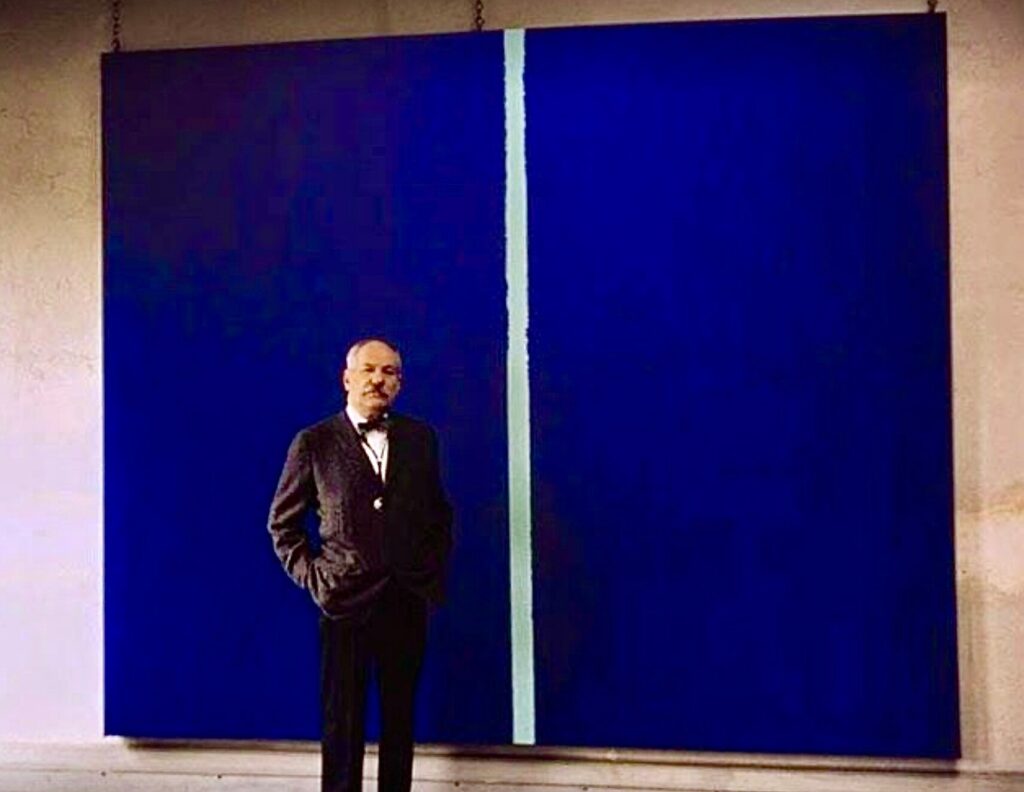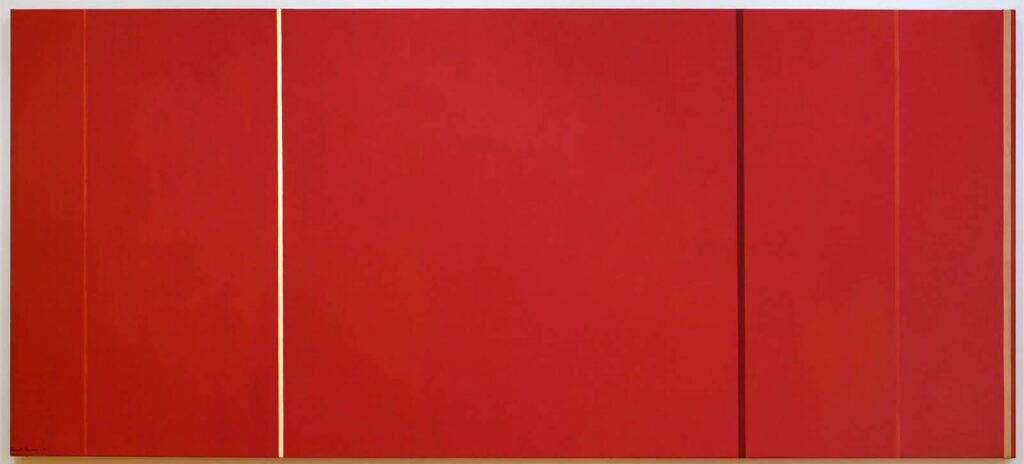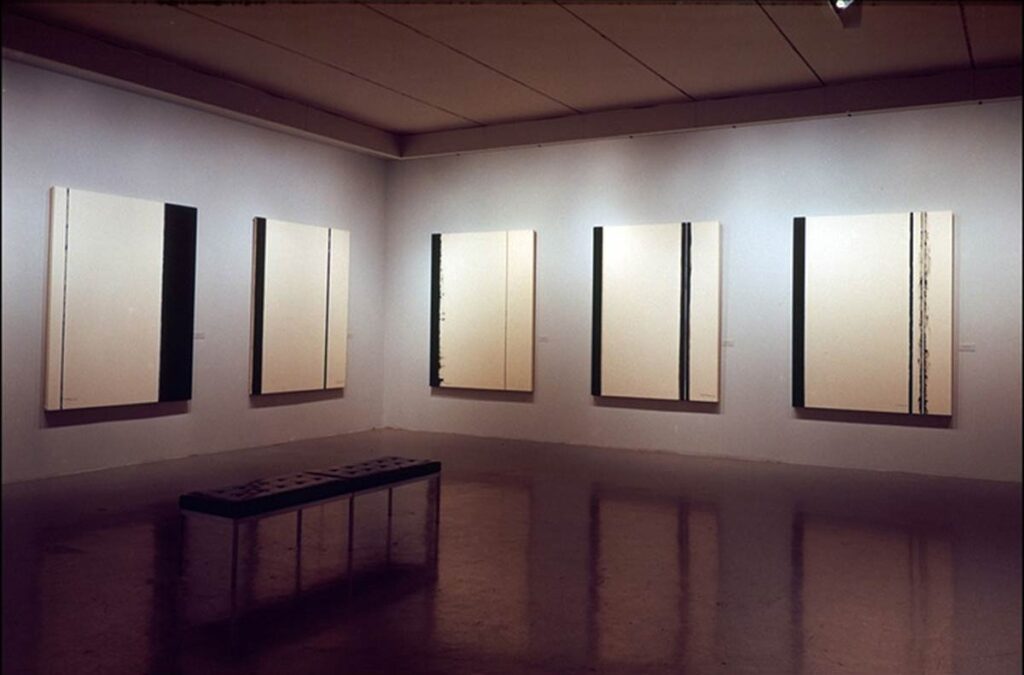Barnett Newman
Barnett Newman was a pioneering figure in the Abstract Expressionist movement, renowned for his minimalist approach and profound use of color and form. His work is characterized by large fields of color interrupted by vertical lines, known as “zips,” which create a dynamic interaction within the composition. Newman’s art aimed to evoke a sublime, almost spiritual experience, transcending traditional aesthetic boundaries.

Early Life and Education
Barnett Newman was born on January 29, 1905, in New York City to Jewish immigrant parents from Poland. His early education included studying philosophy at the City College of New York and attending the Art Students League, where he honed his skills in drawing and painting. Newman’s background in philosophy deeply influenced his artistic vision, imbuing his works with a conceptual and intellectual rigor that set him apart from many of his contemporaries.
Development of a Unique Style
Newman’s early artistic endeavors were diverse, including drawing, painting, and even political cartoons. However, it wasn’t until the late 1940s that he began to develop the distinct style for which he is best known. This style emerged from his belief that art should evoke a direct emotional response, rather than simply depict objects or scenes.
In 1948, Newman created his first “zip” painting, which featured a single vertical line running through a field of color. This simple yet powerful composition became the hallmark of his work, representing a radical departure from the gestural brushwork of his Abstract Expressionist peers. Newman’s zips served to divide and unite the color fields simultaneously, creating a sense of tension and harmony within the canvas.
Notable Works
1. “Onement I” (1948)
“Onement I” is considered a pivotal work in Newman’s career, marking the first appearance of the zip. The painting features a deep, monochromatic red field bisected by a single, slightly irregular vertical line in a lighter red. This seemingly simple composition is imbued with profound meaning, representing Newman’s exploration of creation and individuality.
The title “Onement” suggests a state of being unified or at one, reflecting Newman’s philosophical interests in existentialism and the human condition. The zip serves as a symbol of division and unity, suggesting the possibility of harmony amidst separation. “Onement I” established the framework for Newman’s subsequent works and solidified his place in the Abstract Expressionist movement.

2. “Vir Heroicus Sublimis” (1950-51)
“Vir Heroicus Sublimis,” which translates to “Man, Heroic and Sublime,” is one of Newman’s most celebrated and monumental works. Measuring nearly 18 feet in width, the painting features an expansive red field punctuated by several vertical zips in varying widths and colors. The vast scale of the work invites viewers to immerse themselves in the color field, experiencing a sense of awe and contemplation.
Newman intended this painting to evoke a profound emotional and spiritual response, challenging viewers to confront their own existence and humanity. The title and composition reflect Newman’s belief in the potential for heroism and sublimity in the human experience, urging viewers to consider the broader implications of their interactions with the artwork.

3. “The Stations of the Cross: Lema Sabachthani” (1958-66)
“The Stations of the Cross: Lema Sabachthani” is a series of 14 paintings that represents one of Newman’s most ambitious and spiritually charged projects. The title, which translates to “Why have you forsaken me?” from Aramaic, references Jesus’ cry of despair on the cross. The series explores themes of suffering, redemption, and transcendence through abstract means.
Each painting in the series features stark, black and white compositions with varying configurations of zips. The simplicity and austerity of the works convey a profound sense of gravity and contemplation, inviting viewers to reflect on the spiritual and existential themes embodied in the series. This body of work is considered a pinnacle of Newman’s career, exemplifying his ability to convey deep emotional and philosophical content through abstract form.

Techniques and Innovations
Newman’s approach to painting was marked by his innovative use of color and form. He often applied paint in broad, even fields, creating smooth, uninterrupted surfaces that draw the viewer’s eye across the canvas. His zips were typically created by masking off sections of the canvas, allowing him to achieve precise, sharp edges.
One of Newman’s key contributions to modern art was his emphasis on the viewer’s experience. He believed that art should be an immersive, contemplative experience, encouraging viewers to engage deeply with the work on an emotional and intellectual level. His large-scale canvases and bold compositions were designed to evoke a sense of awe and introspection, challenging traditional notions of what art could be.
Influence and Legacy
Barnett Newman’s work had a profound impact on the development of modern art, influencing a generation of artists who followed him. His minimalist approach and focus on color and form can be seen in the works of artists such as Mark Rothko, Ad Reinhardt, and Frank Stella. Newman’s emphasis on the experiential nature of art also paved the way for the development of installation art and other immersive art forms.
Despite facing critical resistance during much of his career, Newman’s work has since been recognized as a cornerstone of Abstract Expressionism and minimalist art. His paintings are held in major museums and collections around the world, including the Museum of Modern Art in New York, the Tate Modern in London, and the National Gallery of Art in Washington, D.C.
Personal Life and Challenges
Newman’s personal life was marked by both triumphs and struggles. He married Annalee Greenhouse in 1936, and the couple enjoyed a supportive and collaborative relationship throughout his career. However, Newman faced significant challenges in gaining recognition for his work, often struggling financially and battling critical indifference.
Despite these challenges, Newman remained committed to his artistic vision, producing a body of work that continues to resonate with viewers and critics alike. His dedication to his craft and his ability to convey profound emotional and philosophical themes through abstract means have cemented his place as one of the most important artists of the 20th century.
Conclusion
Barnett Newman was a pioneering figure in Abstract Expressionism, whose innovative use of color and form and focus on the viewer’s experience left a lasting impact on modern art. Through his most notable works, such as “Onement I,” “Vir Heroicus Sublimis,” and “The Stations of the Cross: Lema Sabachthani,” Newman explored themes of individuality, heroism, and transcendence, creating powerful and evocative compositions that continue to inspire and challenge viewers. His legacy as a master of color fields and vertical zips endures, leaving an indelible mark on the art world.



